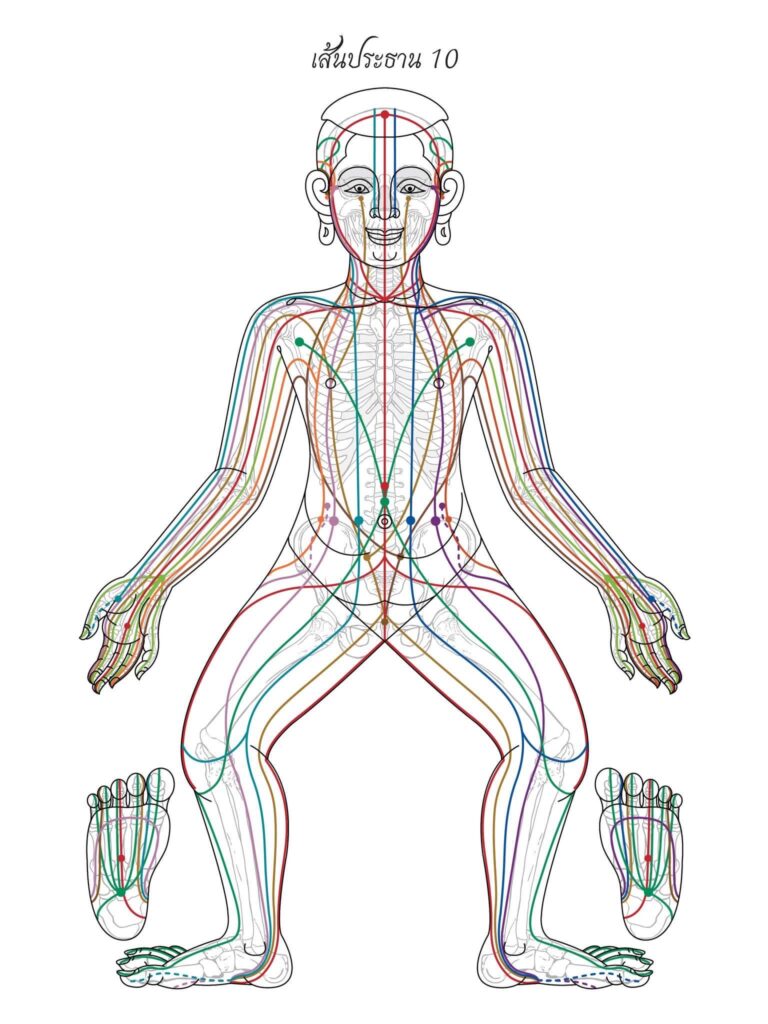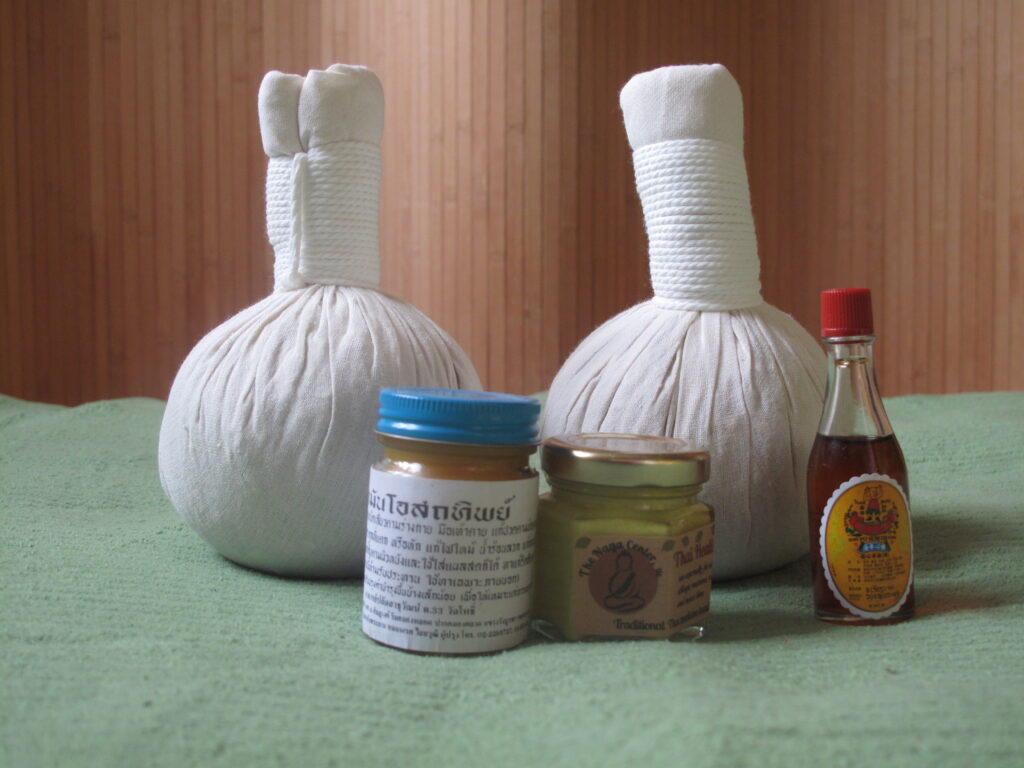
In my late 20’s my initial simple desire was to learn Thai massage as it was the best massage I had received, and it fitted with my developing career path in Yoga at that time. Perhaps naively I thought I would do a couple of courses and off I would go. I wasn’t really expecting to embark on an amazing adventure of lifelong learning , with lots of confusion along the way and to become immersed in another culture and worldview ; but I’m grateful I chose this route, am all the richer for it, and hopefully my clients appreciate it too.
My first courses were in London, UK , they were great, I learned good bodywork skills and they got me going . My curiosity was piqued and off I went to Chiang Mai, Thailand, in 1999 to see what else I could learn. In those pre internet days I rocked up at addresses found in the Lonely Planet guidebook, posted on cafe noticeboards or given to me by other students. I recognised what I was taught and what I received and had an interesting time. Receiving massage in a wide range of places was a fascinating cultural adventure and way of learning too. BUT I am the type of person who likes to know what I am doing and why in rigorous detail ( a blessing and a curse), in other words I felt the need for a solid theoretical base, and so far this was lacking or had been glossed over briefly and vaguely. For me, if I was going to charge money for this service I felt some responsibility to be as clear as possible about this.

I was originally told by my western teachers that there was no anatomy (in the bio-medical sense) in Thai massage , just ‘energy lines’, and that we were working on the ‘energy body’; a map taken from esoteric yoga theory was given by way of a guide . This didn’t really satisfy me or make sense in the context of what often felt like an intensely physical massage , but initial searches in Thailand didn’t get me any further . Amongst what I had been given so far by both western and Thai teachers as well as other students was :
- Stop thinking , just meditate and feel (good advice at times in many ways, just not enough for me).
- Just feel along the sen lines (energy lines) and sense for energy blockages. Again, could be helpful, but how to do this ? And what does it mean? Whilst on some level everything is energy, I also find ‘energy blocks’ a tricky and potentially flakey term to use in describing massage.
- Different and contradictory versions of sen line theory and the maps of where these lines were on the body.
- Traditional Chinese Medicine Meridien and acupressure point theory.
- Ayurvedic Medicine theories ( Traditional Indian Medicine).
- Yoga theories .
- Questionable theories given to me by other western massage students that didn’t make any sense to me, or were borrowed from other health and healing systems, and appeared to not have anything to do with Thailand.
In addition there were times when I went to massage teachers who taught this sen line theory , but when they worked on me appeared to be doing all sorts of other things as well that weren’t working in these energy line spaces.
To be fair to the western massage teachers I had , I have since met even fully trained Thai Traditional Medicine doctors who haven’t been able to explain some of these ideas to me clearly. Fair enough, apart from the fact that there was a language barrier at times, somatic arts and healing practices are not an exact science. In addition it seems that there is not total agreement on massage theory systems and ‘anatomy’ charts within Thailand. A lot of research is current with the resurgence of interest in Thailand itself in their own traditional medical system.


In addition there has been historical influence from China and India and early versions of their traditional medical theories, but the idea of a medical culture being imported wholesale seems unlikely. Cultures have aways borrowed and exchanged ideas and then given them back again, so likely there are elements of truths in some of the other ideas and loose theories I was given, but I wasn’t satisfied. It felt that there was a significant theory – practice gap , a language / culture barrier also, and I was blundering in the dark a bit. Yet at the same time I knew that the bodywork I was learning and practicing felt good and was benefitting people. Part of me though was thinking : ‘Phoo Wee , why didn’t I just go to the local college at home and learn remedial / sports massage or something that I can understand’.
I was and am quite happy to accept that different theories co-exist , after all in western bodywork modalities we have osteopathy , chiropractic, holistic massage , sports massage, remedial massage , Rolfing , mysofacial release and so on , all emphasising one aspect or another of bodywork. What on earth is sports massage anyway ? As my ‘sports massage’ teacher ( I did eventually do a useful course in this) correctly asked, and then commented that you can’t massage a sport ( but that he couldn’t change the name of his school after 30 years ). If someone from Asia popped up in the UK to learn massage, they would no doubt encounter similar confusions to me in reverse.
Then one day by chance , better answers popped up in an online search .
Nephyr Jacobsen , head teacher and massage therapist at the Naga Center in Portland, Oregon, USA had been asking many of the same questions and had found a Thai speaking source who had studied Thai Traditional Medicine . I did Nephyr’s online Thai Medical Theory for Bodyworkers course where all my confusions were discussed and clarified ( as far as is ever possible) . I even went to Portland to study with her. America was not particularly on my list of places to go to study Thai massage, but I had a great time and Portland was a treat to visit.

In summary I came to more deeply understand that medicine is very deeply related to the culture and environment that it develops in, and Thailand (of course) has it own extensive traditional medicine which is deeply embedded in Thai culture and Buddhism . Massage is just one part of a rich and old system that includes anatomy and physiology (described a little differently to bio-medicine, but recognisably) , meditation, herbal pharmacology and sometimes shamanistic type practices (some of this not so different to modern medicine on closer examination). The massage or bodywork also includes use of herbal compress , various balms , Tok Sen ( use of a hammer and peg in the gentlest sense ), sometimes cupping (suction cups placed on the body) , sometimes scraping ( with a buffalo horn or spoon on the skin ), traditional chiropractics (for want of a better word) and even herbal poultices laid on the body and then set on fire . Phew , I really should have gone to the local college massage course.

From these courses online and in the USA , I got a Thai massage theory that I can understand and underpins my thinking when I work . I wouldn’t entirely discount the other ideas that I had been taught , aspects of some of them make sense (maybe more so for others), but overall I still struggle to understand them in the context of massage.
I’ve been back to Thailand a few times since discovering all this, and now it all makes sense. I both know quite a lot and have experience, but also know very little really of the vast world of Thai Traditional Medicine; I have no hope of understanding it all (without moving there and learning the language properly), but am satisfied that I don’t need to in order to do good work that makes sense to me and produces good results. I believe Thai massage is an amazing multi-dimensional modality that can really help people and covers ground that sometimes other approaches don’t. I shall carry on prodding and poking, researching and practicing. As a huge bonus I have fallen in love with Chiang Mai on my research trips there .



If you are interested to find me for massage, I live in Totnes, Devon UK where I run my business . All the info is here.
If you are a massage student looking to learn Thai massage here are a few resources. There are many schools in Chiang Mai and new ones all the time so this is a tiny selection.
London UK, Kira Balaskas, School of Thai Yoga Massage .
Portland , Oregon, USA . Nephyr Jacobsen, The Naga Center
Chiang Mai, Thailand. Sunshine Massage School
Chiang Mai, Thailand . Ban Hom Samunphrai
Nephyr’s book on Thai Medicine for Bodyworkers
Supporting Me.
The content of my website is free but not cheap, I put a lot of work into it, so any donations to support the running of this website , or show your appreciation for any articles/blogs would be greatly appreciated . Thank you .
Subscribe to my newsletter. You can subscribe to my newsletter for occasional news and updates on new articles/blogs by signing up in the boxes below or to the right depending what you are reading this on .
Buy me a coffee. If you can support me by buying me a coffee either here https://www.buymeacoffee.com/nev or via the coffee cup icon that would be amazing – thank you.
Follow me on Medium. You can also support me by following me on the writer’s platform Medium .
Share my posts. If you know others who would appreciate any of my blog posts please feel free to forward or share on social media . Sharing is caring.
Thank you.
